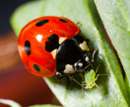I'm bright red and I taste foul -- the message behind color and the ladybird's spots

(Phys.org) -- To humans they might be pretty and small, the inspiration for nursery rhymes and children's clothing, but the redder the lady bird, the worse it tastes to the bird which tries to eat it, an international research team, including Dr. John Endler from Deakin University has found.
Dr. Endler from the University's Centre for Integrative Ecology, Dr. Jon Blount from the University of Exeter and Dr. Mike Speed from the University of Liverpool in the UK and others investigated the impact of food resources on the ladybird's distinctive color and spots.
"While ladybirds are a friend to the gardener, in that they prey on pests that attack plants such as aphids, they are also attractive to birds who use them as food source," Dr. Endler explained.
"As such they are known as a prey species and they use their spots and colour to warn off birds and other predators to find an easier meal.
"However as our research showed, not all lady birds are born equal, some are less tasty than others and the key to the difference is in the color."
Dr. Endler, who has a passionate interest in understanding the link between colouration and warnings in wildlife literally took a bird's eye view for the research project.
Dr. Endler examined how the different ladybird colorings and contrasts would look through the eye of a starling.
"While we can't always notice the difference in the colour or the spots on a ladybird, a bird or predator can," he said.
"Our results showed that the starling would be able to discriminate between the colour and spot variations in the ladybird.
"This information coupled with our findings that the brighter the ladybird the more toxic it is indicates that the redder ladybird has less chance of becoming a meal."
Dr. Endler said ladybirds used a lot of energy to produce and maintain the bright colour and the bitter taste.
"What we also found was that access to a good diet influenced this potency in colour and toxicity," he said.
"We also found that the brighter the 'signal' or the red colour on the ladybird the more effective the warning, in other words it honestly told predators this particular ladybird is not for the taking."
Dr Endler said while the result may seem small, much like the lady bird itself, it was an interesting result.
"Nobody has examined the relationship between the colour intensity and distasetfulness before," he said.
"Previously people just classified colour patterns as bright/warning, conspicuous, versus dull/cryptic less conspicuous.
"Whereas now we see that there are varying degrees of conspicuousness and they relate directly to the degree of toxicity, which makes sense.
"There are some analogies in this discovery with sexual selection in other species, where brighter colours are often associated with better health, disease resistance and food-finding ability."
More information: How the ladybird got its spots: effects of resource limitation on the honesty of aposematic signals, Jonathan D Blount, et al., Functional Ecology, 2012
Journal information: Functional Ecology
Provided by Deakin University















